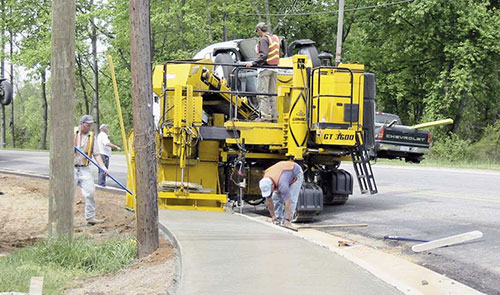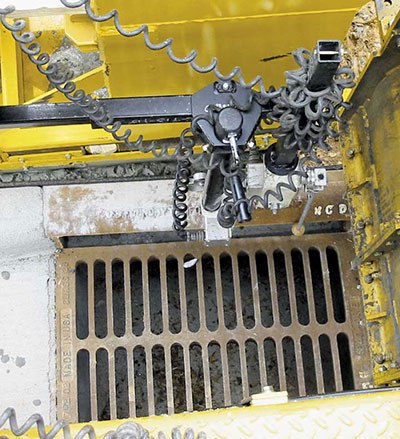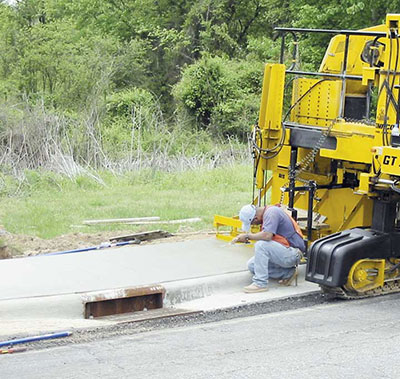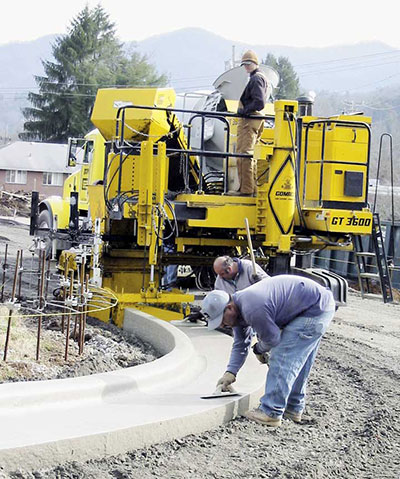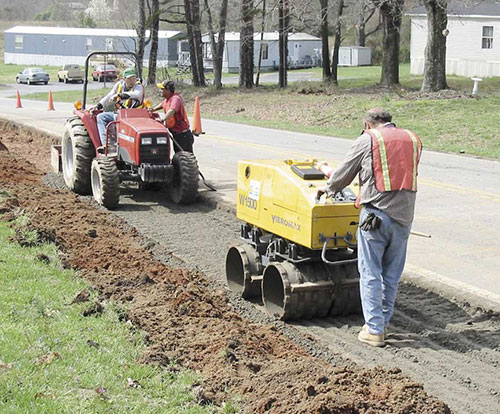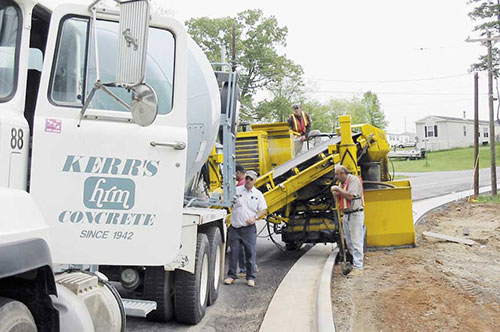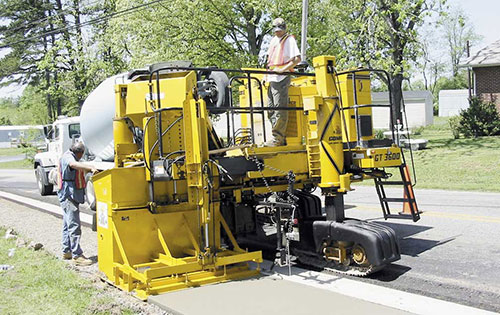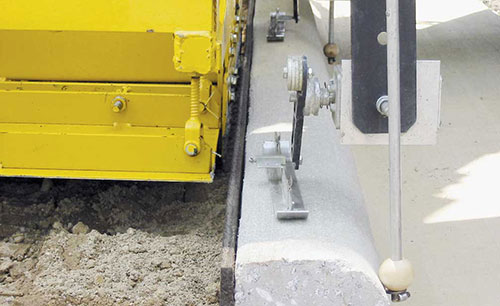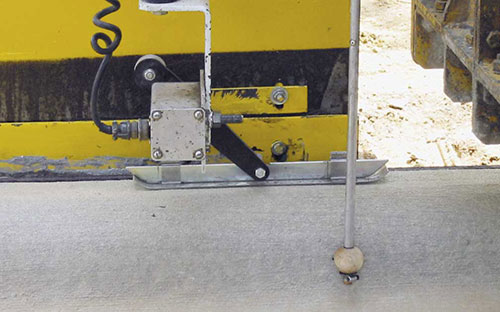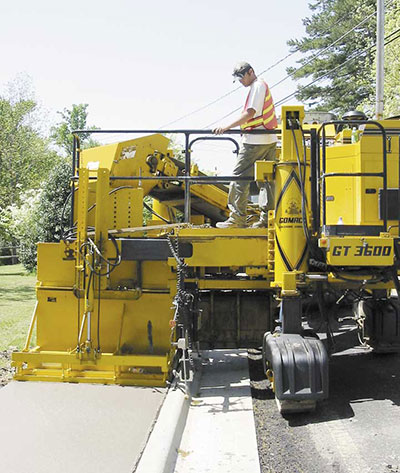GOMACO World Index --- GOMACO World 31.2 - October 2003
Chris Buchanan Explains Stringless Sidewalk
Buchanan and Sons Inc. has been slipforming curb and gutter and sidewalk with their GT-3600 since 1999. Chris, the youngest of the Buchanan sons, is the company's vice president and GT-3600 operator. Of all the different profiles they slipform, sidewalk is Chris' favorite, claiming that "it just looks pretty."
They slipformed all of their sidewalk the traditional way, setting their stringline and trimming as they poured. Then they bid and won a project in Saw Mills, North Carolina, requiring them to slipform approximately 3000 feet (914 m) of curb and gutter. With the curb and gutter in place, they would then have to come back and scab on a five foot (1.5 m) wide sidewalk onto the newly slipformed curb and gutter.
The first step was preparing the grade. Equipment was brought in to create the required soil-cement treated subgrade. Once the grade was ready, the GT-3600 was moved in.
A North Carolina Department of Transportation (NCDOT) standard 30 inch (762 mm) curb and gutter with a three inch (76 mm) radius on the face and flow line was slipformed first.
The sidewalk could not be trimmed and poured simultaneously because Buchanan's do not have a left-side trimmerhead discharge on their machine. Buchanan instead brought in a tractor with a box blade.
"The trimmer would have discharged towards the curb so we had to use our tractor instead," Buchanan explained. "We have two guys with rods and levels checking grade. My brother, Carl Jr., is on his tractor with a five foot (1.5 m) box blade. We get our angle right and blade through, gauging off the curb to get everything to grade."
The project had some challenging aspects with tight clearances because of utility poles and trying to set stringline to match the existing curb and gutter. Buchanan called GOMACO with an idea.
"It's about impossible to set stringline and pour to the back of curb," Buchanan said. "I had read other articles about guys sensoring off their existing curb and pouring their sidewalk that way. I figured I should be able to do it with my machine, too."
A view from the operator’s platform looking down as the sensor rolls across the top of a catch basin. The photo to the right shows the finished sidewalk.
The needed parts and sensor brackets were shipped to North Carolina. A week after pouring the curb and gutter, slipforming the scab-on sidewalk began. The GT-3600 needed a quick mold change and some reconfiguration of the leg positioning and it was ready to go.
"It doesn't take very long to switch to the sidewalk mold. You just pull the two drawbar pins, unhook the holddown, pick up off the mold, drive over the sidewalk mold and set down on it," Buchanan explained. "It took me a while to figure out how I wanted to set up the machine. That's where the adjustable legs are great. I can move them where they need to be."
Buchanan was concerned the tracks would mark on his newly poured curb and gutter. With the GT-3600's All-Track Positioning (ATP), he was able to sideshift the back leg over so it was running on the asphalt road, straddling the new curb and gutter.
"The first 50 feet (15.2 m) didn't pour very good because I didn't have it adjusted right," Buchanan said. "My brother wanted to park the thing and start handforming. I told him not to bail out yet and to give me a few more minutes to readjust some things. After that, we poured 200 feet (61 m) more and he was very happy with it saying 'I'm glad I thought of this, it works pretty good.'"
The sidewalk is five feet (1.5 m) wide and four inches (102 mm) thick. The concrete is a NCDOT 4500 psi (31 MPa) standard mix design for both the sidewalk and curb and gutter. Slump averaged three inches (76 mm) for the sidewalk and two to 2.5 inches (51 to 64 mm) for the curb and gutter.
Perhaps the most challenging aspect of the project was getting the sensors set and the wands at the proper angle.
Buchanan had to reverse the direction of his sensors so he could pull the grade skis across the curb instead of pushing them along. By pulling the skis, it helped keep them from catching on anything and getting pushed back into the sensor and damaging it. The tube is still positioned in front of the sensor and the GT-3600's controller stays in the push operating position.
He also had to run the wand at a 45 degree downward angle instead of the normal horizontal position. If the wand had been kept horizontal, it would have been flush with the bottom of the sensor and the sensor would have been hitting the curb.
"I had the front sensor in line with the front of the mold and the rear sensors in line with the back of the mold," Buchanan explained. "The set up kept the front of the mold from catching. It looked awkward at times because the front of the machine would be high, but at the mold, it was perfect."
The trimmerhead was sideshifted and vertically lifted out of the way while the sidewalk was slipformed.
Another trick Buchanan used was slipping a round, wooden ball on the end of the steering wand. The ball kept the wand from falling into and catching on the joints in the curb.
"It just rolls round and round and doesn't fall into any holes," Buchanan said. "I even rolled it over the top of a catch basin with no problems. The sidewalk went right to the back of it, the finishers edged it and we kept on going. I knew if we did the catch basin we'd be showing off, because most people just leave them. They won't even tie into them when they're pouring their curb. I think it's aggravating not to and then have to go back and do them by hand."
Very little finishing work had to be done to the sidewalk because of the concrete mix design and the set up and finishing capabilities of the GT-3600. The sidewalk was edged along the expansion joint separating it from the curb, bull floated, and joints were cut in. Control joints were saw cut every five feet (1.5 m) and expansion joints were every 50 feet (15.2 m).
"A lot of the sidewalk didn't even have to be edged and I think that had a lot to do with the mix," Buchanan said. "I had the mold so close to the back of the curb that it was actually rubbing against the expansion joint. There was nothing that could physically blow out.
"The big trick to it was that I didn't lock the mold down. The reason I left my mold loose is when I set the mold down, I could push it over two or three inches (51 to 76 mm), set it down all the way, and then set it into the curb. I wasn't trying to push in or out while I was pouring, only when I was setting up each time."
Close-up photographs of the sensors illustrate Buchanan’s unique set up and the exact positioning of the sensors and wands.
The 3000 feet (914 m) of sidewalk was slipformed in three days. The best production was approximately 1100 feet (335 m) slipformed during a seven hour day.
"We're the only ones around here that do this and it's going to be one of our selling points," Buchanan added. "The GT-3600 has allowed us to do something we've been doing all along, concrete work, at such a fast rate. It's been opening doors to do more grading, more storm drainage and other aspects of the project, not just handforming 3000 feet (914 mm) of curb and sidewalk."
Because of the GT-3600 and the Buchanans' own work ethic and desire to produce a quality product, the company is growing at a phenomenal rate.
"We are one of the fastest growing companies in western North Carolina and the GOMACO curb machine is what got it all started," Buchanan said. "We just got a project where we were preselected and were the only contractor allowed to bid on it due to our honesty, quality of work and other factors like that."
With all the success they're experiencing, the company hasn't forgotten their roots and the lessons Carl Buchanan, the company's founder, taught them.
"Our dad taught us to take pride in our work and take the time to do the job right," Buchanan explained. "The best advice I can give is buy a GOMACO. I know I wouldn't be pleased with anything else because I wouldn't be able to do the things I'm doing now. A lot of my competition are running a locally built product, but me, I'm running a real machine."
Subscribe to Receive GOMACO World Magazine
